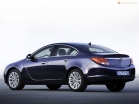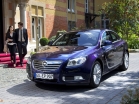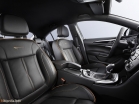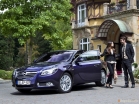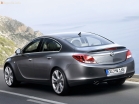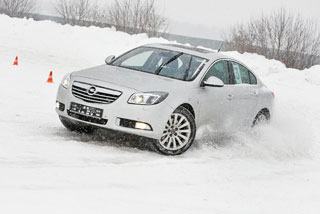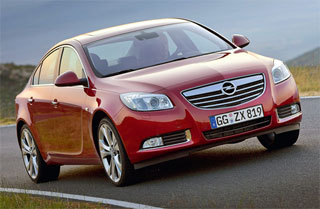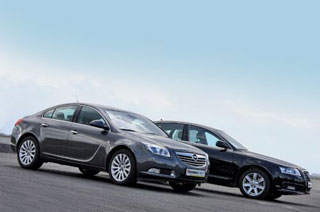Test drive Opel Insignia sedan since 2008 sedan
New stroke
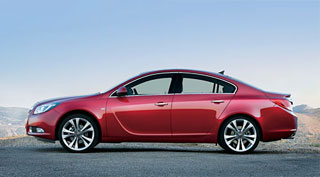 The main feature of the new Opel model is not straight. This is an elegant stroke on the sidewall. There are about the same special need for it as in the notorious keel of the models of the 60s. The main task of this spectacular detail is to emphasize the novelty of the new Opel flagship and its difference from others. Including from the Vectra replaced by this model.
The main feature of the new Opel model is not straight. This is an elegant stroke on the sidewall. There are about the same special need for it as in the notorious keel of the models of the 60s. The main task of this spectacular detail is to emphasize the novelty of the new Opel flagship and its difference from others. Including from the Vectra replaced by this model. ... and not surprising. It would be strange if Opel, designing his new flagship model, did not set the task of making the best car. This is how the company’s employees formulated the concept of Insignia. No, not the best in the world: class D somehow does not have the limiting characteristics. General Motors Europe has been concerned about making the best car in this segment. Despite all the successes of various crossovers and minivans, the audience did not stop loving classic models - just a sedan or just a hatchback. Increased minivan capacity and increased cross -country crossover impose increased sizes. So, the increased cost of production and a slightly worst economy. You understand that in our time each euro in the account of both manufacturers and consumers.
Opel learned about his own experience about the dislike of buyers-created on the basis of the predecessor of Insignia Vectra, the Signum Signum Polominin-Poluhtchbek did not enjoy the demand that its creators counted on. Therefore, Insignia began to be done according to other canons, although it was not without originality. A five-door hatchback and a four-door sedan is not so easy to distinguish from each other. Remember the new Skoda Superb? Its trunk can be opened both in a ninetegeal manner, and like a hatchback. Opel uses a similar idea, but only in design. Outwardly, the fifth door of the hatchback differs from the lid of the trunk and the rear window of the sedan only with connectors. Well, also the presence of a wiper. However, there is a suspicion that the wiper is only a tribute to tradition. After all, if
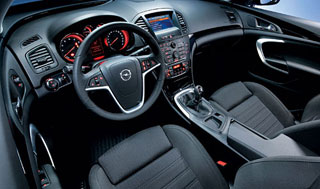 the sedan does not need him, then what is he at the hatchback? Although after a trip by car in heavy rain, you begin to think that the wiper would not have prevented the sedan. Moreover, according to official figures, he does not spoil the INSIGNIA aerodynamics at all - both versions indicate an aerodynamic resistance coefficient of 0.27, which is impressive even for today's times.
the sedan does not need him, then what is he at the hatchback? Although after a trip by car in heavy rain, you begin to think that the wiper would not have prevented the sedan. Moreover, according to official figures, he does not spoil the INSIGNIA aerodynamics at all - both versions indicate an aerodynamic resistance coefficient of 0.27, which is impressive even for today's times. The bad weather helped to evaluate the excellent handling of the machine. Even without an all -wheel drive, Adaptive 4x4 Insignia kept well on a given path, despite the powerful jets of rain and fallen leaves on the road. Of course, before that I had to switch the suspension ... No, not only the suspension. When the sports regime is turned on, the FlexRide system changes the settings and suspension and steering wheel amplifier, and the accelerator pedals, ESP, and, of course, automatic transmission, if any. Additionally, a change in character is emphasized by the changing lighting of the instrument shield-it becomes intense red. In this sports mode, we rode in the rain. For a smoother movement in all senses, there is a TOR mode, as well as SPORT turned on by a separate button on the instrument panel. The suspension in this mode very skillfully hides irregularities, the steering wheel becomes softer, and when the pedal of the gas, the tachometer arrow does not jump to the right, but moves carefully. If both Sport and Tour are not turned on, Flexride selects the mode itself.
We were demonstrated at the training ground of the Austrian Society of motorists, motorcyclists and auto-motorists. There are as many in the country in the country, and any person for them for quite affordable money (from 159 to 485 euros) can get driving skills in various situations. At the Brandlhof-Zaalfelden training ground, Insignia was waiting for us, equipped with a small additional device-a PDA connected to Flexride. And one could observe the operation of the system right on the go. On the display of the CCP, it was clear how the settings of different nodes and assemblies were changing when moving in different conditions. Here we turn at a speed of 50 km/h - and everything remains more or less
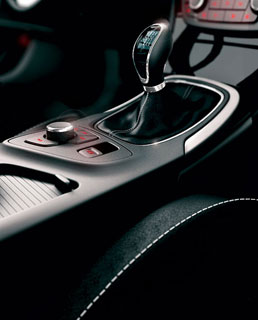 smooth. But the same turn is 70 - and the suspension becomes tougher. The system regulates the operation of the machine not only when the speed changes, but also simply with different traffic modes - when accelerating or braking, they do not work like that with the established movement in a straight line.
smooth. But the same turn is 70 - and the suspension becomes tougher. The system regulates the operation of the machine not only when the speed changes, but also simply with different traffic modes - when accelerating or braking, they do not work like that with the established movement in a straight line. There we also met with the new Opel Eye system. Opelian eyes are doing what the driver should actually do: he monitors signs and markings. The camera in front of the rear view mirror reads signs already a hundred meters forward and at the entrance to them displays information on the display in the center of the instrument panel. So far, they have limited themselves to signs such as speed restrictions or prohibition of overtaking, so as not to dissolve the driver too much. The second function of the camera is traffic tracking. If we leave our strip without a turn indicator, a sound signal reminds us of this. In Audi A4, this is much more spectacular: the steering wheel begins to vibrate. And Citroen vibrators are built into the driver's seat. Opel seems to have decided to save. Not only is the squeak cheaper, it also simplifies logistics - do not order several types of seats or rudders from suppliers.
The use of Opel Eye is still limited by the landfill, this system was not even on the test InSignia. But they were all equipped with the latest and (so far) unique lighting system. This is not the first time Opel does this: once it was this brand that was the first to introduce rotary headlights. Now the next step is taken: the light bundle automatically changes not only from the neighbor to the far, but also in seven modes. Moreover, without the participation of the driver - electronics collects information about the speed, angles of rotation of the car and the steering wheel and the conditions of visibility. At a speed of less than 30 km/h (this is a limit for pedestrian zones in Europe) The beam is very wide. Up to 50 km/h - city regime. It is even weaker than the near light, because lights should burn in cities. Next are the modes of suburban movement (50-100 km/h), for the motorway, for rainy weather (the asymmetry of lighting is enhanced) and lateral light for rotation. Noticing the changes is not so simple-that, probably, it is worth considering a compliment. After all, it is for the most natural lighting Opel and the famous Hella that everything came up with.
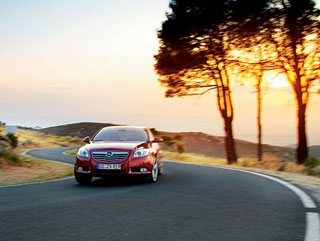 The most noticeable function of the AFL+ system is automatic switching from the far to the near. On a flat road to ride with him is a pleasure: the headlights switch, as soon as the oncoming or passing car will appear ahead. But on the mountain roads, we seem to have delivered several unpleasant moments to several drivers: in corners or raising, oncoming cars are sometimes too close to the field of view, and even for a second, but get their portion of our high world. As a result, in the winding areas of humanitarian reasons, we forcibly turned on the near light.
The most noticeable function of the AFL+ system is automatic switching from the far to the near. On a flat road to ride with him is a pleasure: the headlights switch, as soon as the oncoming or passing car will appear ahead. But on the mountain roads, we seem to have delivered several unpleasant moments to several drivers: in corners or raising, oncoming cars are sometimes too close to the field of view, and even for a second, but get their portion of our high world. As a result, in the winding areas of humanitarian reasons, we forcibly turned on the near light. There is a lot of new in Insignia, so the new style was not in vain promised to us completely the wrong Opel to which we are used to. The authors of the interior design clearly used not only the ruler and compass, as was the case with Vectra. Not that we hate simple and clear forms, just changes are sometimes necessary. Especially if the fashion has changed so noticeably. The Insignia salon looks no less impressive than the closest competitors. The sweeping console plus accents scattered in different places in the form of swift ... swift ... Well, here is the thing, in the form of which under the doors and overall lights on the headlights are made. And there are many chrome details. Everything looked just wonderful in the interior of a relatively inexpensive version, but in Cosmo, which is more vicious, against the background of the tree decoration, brown plastic on the console seemed ... a little too American.
But in the cabin, luxurious chairs with a mass of adjustments, and in the most advanced climate control options-ventilation grilles on the rear door racks. The Russian adaptation, perhaps, will be required a trunk: we are not used to without a spare wheel. Conditions do not allow. Then you will have to come to terms with the loss of some liters there, but the floor increased due to the spare wheel of normal size will rise just to the level of folded back seats. And let Europeans suffer themselves without a spare and a difference
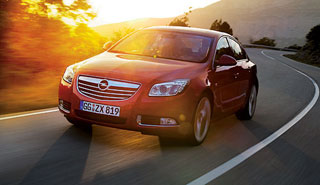 levels in the trunk. And they are comforted by excellent engines, automatic light, an excellent chassis and an excellent design - this is both in common. Thanks to this set, Insignia may really be the best car in the segment - if not for everyone, then for many.
levels in the trunk. And they are comforted by excellent engines, automatic light, an excellent chassis and an excellent design - this is both in common. Thanks to this set, Insignia may really be the best car in the segment - if not for everyone, then for many. Abstracts after
1. Almost simultaneously with the start of Insignia sales in Germany, Auto Bild magazine called Opel the highest quality brand among European and German manufacturers. For the third time.
2. A full list of options includes two types of bodies, seven engines, two drive options and four configurations.
3. The rejection of the spare wheel allows not only to increase the volume of the trunk, but also to reduce the equipped mass and thereby reduce fuel consumption.
4. Dynamics, original style and practicality are always in fashion.
Opel Insignia
Engine (gasoline) in a row 4-cyl.
V6 working volume (cubic cub) 1598 /2792
Power (L.S. at rpm) 115 at 6000/260 at 5500
Moment (Nm at rpm) 155 at 4000/350 at 1900-4500
Front /constant full drive
Gearbox fur. 6-speed /aut. 6-speed
Length/width/height (mm) 4830/1856/1498
Equipped mass (kg) 1503 /no data
Maximum speed (km /h) 192 /250*
Acceleration to 100 (c) 12.9/7.1
Fuel consumption, city/highway (l/100 km) 10.6/5.9/16.9/7.4
Price in Moscow (rub.) 670,000/no data
*Limited by electronics
Text: Valery Chusov
Source: "Autopilot"

